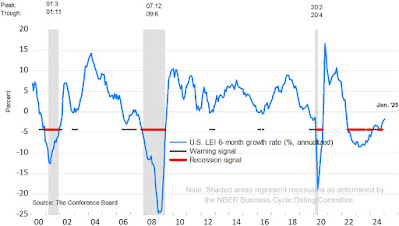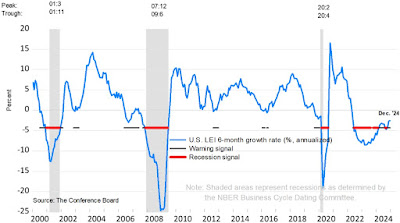Leading Economic Index for August 2025
Index for August 2025: 98.4 (The baseline 100 score is associated with 2016 data.)
==============
Predicted: -0.3%
- Actual: -0.51% (-0.5 point Month-on-Month)
- Change from 12 Months Ago: -3.9% (-4.0 points)
==============
- LEI for July 2025: 98.9
- LEI for June 2025: 98.8
- LEI for May 2025: 99.1
- LEI for April 2025: 99.1
- LEI for March 2025: 100.4
- LEI for February 2025: 101.2
- LEI for January 2025: 101.4
- LEI for December 2024: 101.6
- LEI for November 2024: 101.7
- LEI for October 2024: 101.4
- LEI for September 2024: 101.7
- LEI for August 2024: 102.1
The yellow-highlighted percentage is the month-to-month change for the index. The "predicted" figure is what economists were expecting, while the "actual" is the true or real figure.
The LEI is a composite of 10 of the nation's economic data releases that's put together by The Conference Board. Statistically, the components listed below have shown a significant increase or decrease before national economic upturns or downturns:
- The Standard + Poor's 500 Index
- Average weekly claims for unemployment insurance
- Building permits for new private housing
- The interest rate spread between the yield on the benchmark 10-Year Treasury Note and Federal Funds
- ISM® Index of New Orders
- Manufacturer's new orders for consumer goods or materials
- Manufacturers' new orders, non-defense capital goods excluding aircraft orders
- Average weekly manufacturing hours
- Average consumer expectations for business conditions
- Leading Credit Index™
"...'In August, the US LEI registered its largest monthly decline since April 2025, signaling more headwinds ahead,' said Justyna Zabinska-La Monica, Senior Manager, Business Cycle Indicators, at The Conference Board. 'Among its components, only stock prices and the Leading Credit Index supported the LEI in August and over the past six months. Meanwhile, the contribution of the yield spread turned slightly negative for the first time since April.
'Besides persistently weak manufacturing new orders and consumer expectation indicators, labor market developments also weighed on the Index with an increase in unemployment claims and a decline in average weekly hours in manufacturing. Overall, the LEI suggests that economic activity will continue to slow.
A major driver of this slowdown has been higher tariffs, which already trimmed growth in H1 2025 and will continue to be a drag on GDP growth in the second half of this year and in H1 2026.
The Conference Board, while not forecasting recession currently, expects GDP to grow by only 1.6% in 2025, a substantial slowdown from 2.8% in 2024.'..."
Labels: consumer, consumers, disinflation, Economy, FedPrimeRate, FedPrimeRate.com, inflation, Leading_Economic_Index, leading_economic_indicators, Recession_Risk, Recession_Signals, Recession_Warning
|
--> www.FedPrimeRate.com Privacy Policy <--
CLICK HERE to JUMP to the TOP of THIS PAGE > SITEMAP < |











